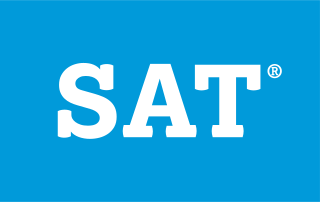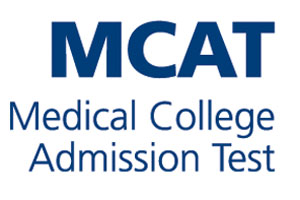Related Research Articles

The ACT is a standardized test used for college admissions in the United States. It is currently administered by ACT, a nonprofit organization of the same name. The ACT test covers four academic skill areas: English, mathematics, reading, and scientific reasoning. It also offers an optional direct writing test. It is accepted by all four-year colleges and universities in the United States as well as more than 225 universities outside of the U.S.

The SAT is a standardized test widely used for college admissions in the United States. Since its debut in 1926, its name and scoring have changed several times. For much of its history, it was called the Scholastic Aptitude Test and had two components, Verbal and Mathematical, each of which was scored on a range from 200 to 800. Later it was called the Scholastic Assessment Test, then the SAT I: Reasoning Test, then the SAT Reasoning Test, then simply the SAT.

Matura or its translated terms is a Latin name for the secondary school exit exam or "maturity diploma" in various European countries centered around the former Austro-Hungarian Empire, including Albania, Austria, Bosnia and Herzegovina, Bulgaria, Croatia, Czech Republic, Hungary, Italy, Kosovo, Liechtenstein, Montenegro, North Macedonia, Poland, Serbia, Slovakia, Slovenia, Switzerland and Ukraine.

Advanced Placement (AP) is a program in the United States and Canada created by the College Board. AP offers undergraduate university-level curricula and examinations to high school students. Colleges and universities in the US and elsewhere may grant placement and course credit to students who obtain qualifying scores on the examinations.
The Preliminary SAT/National Merit Scholarship Qualifying Test (PSAT/NMSQT) is a standardized test administered by the College Board and cosponsored by the National Merit Scholarship Corporation (NMSC) in the United States. In the 2018–2019 school year, 2.27 million high school sophomores and 1.74 million high school juniors took the PSAT. Scores from the PSAT/NMSQT are used to determine eligibility and qualification for the National Merit Scholarship Program.

The College Board is an American not-for-profit organization that was formed in December 1899 as the College Entrance Examination Board (CEEB) to expand access to higher education. While the College Board is not an association of colleges, it runs a membership association of institutions, including over 6,000 schools, colleges, universities, and other educational organizations.
University admission or college admission is the process through which students enter tertiary education at universities and colleges. Systems vary widely from country to country, and sometimes from institution to institution.
The SAT Subject Test in Chemistry was a one-hour multiple choice test given on chemistry by The College Board. A student chose whether to take the test depending upon college entrance requirements for the schools in which the student was planning to apply. Until 1994, the SAT Subject Tests were known as Achievement Tests; until January 2005, they were known as SAT 2s; they are still well known by the latter name. On January 19 2021, the College Board discontinued all SAT Subject tests, including the SAT Subject Test in Chemistry. This was effective immediately in the United States, and the tests were to be phased out by the following summer for international students. This was done as a response to changes in college admissions due to the impact of the COVID-19 pandemic on education.
The SAT Subject Test in United States History was the name of a one-hour multiple choice test given on United States History by The College Board. A student chose whether to take the test depending upon college entrance requirements for the schools in which the student is planning to apply. Until 1994, the SAT Subject Tests were known as Achievement Tests; and from 1995 until January 2005, they were known as SAT IIs. Of all SAT subject tests, United States History was taken the second most, with 119,903 administrations in 2009. On January 19, 2021, the College Board discontinued all SAT Subject tests, including the SAT Subject Test in United States History. This was effective immediately in the United States, and the tests were to be phased out by the following summer for international students. This was done as a response to changes in college admissions due to the impact of the COVID-19 pandemic on education.
In the U.S., the SAT Subject Test in Mathematics Level 2, was a one-hour multiple choice test. The questions covered a broad range of topics. Approximately 10-14% of questions focused on numbers and operations, 48-52% focused on algebra and functions, 28-32% focused on geometry, and 8-12% focused on data analysis, statistics and probability. Compared to Mathematics 1, Mathematics 2 was more advanced. Whereas the Mathematics 1 test covered Algebra II and basic trigonometry, a pre-calculus class was good preparation for Mathematics 2. On January 19, 2021, the College Board discontinued all SAT Subject tests, including the SAT Subject Test in Mathematics Level 2. This was effective immediately in the United States, and the tests were to be phased out by the following summer for international students. This was done as a response to changes in college admissions due to the impact of the COVID-19 pandemic on education.
The SAT Subject Test in Mathematics Level 1 was the name of a one-hour multiple choice test given on algebra, geometry, basic trigonometry, algebraic functions, elementary statistics and basic foundations of calculus by The College Board. A student chose whether to take the test depending upon college entrance requirements for the schools in which the student is planning to apply. Until 1994, the SAT Subject Tests were known as Achievement Tests; and from 1995 until January 2005, they were known as SAT IIs. Mathematics Level 1 was taken 109,048 times in 2006. The SAT Subject Test in Mathematics Level 2 covered more advanced content.
Generally you need to have completed a semester of a pre-calculus class with a solid “B” or better to feel comfortable on the Math 1, whereas the content of the Math 2 test extends through Algebra II and basic trigonometry, precalculus, and basic calculus.
The SAT Subject Test in Biology was the name of a one-hour multiple choice test given on biology by the College Board. A student chose whether to take the test depending upon college entrance requirements for the schools in which the student is planning to apply. Until 1994, the SAT Subject Tests were known as Achievement Tests; and from 1995 until January 2005, they were known as SAT IIs. Of all SAT subject tests, the Biology E/M test was the only SAT II that allowed the test taker a choice between the ecological or molecular tests. A set of 60 questions was taken by all test takers for Biology and a choice of 20 questions was allowed between either the E or M tests. This test was graded on a scale between 200 and 800. The average for Molecular is 630 while Ecological is 591.
The SAT Subject Test in World History was the name of a one-hour multiple choice test given on World History by the College Board. A student chose to take it depending on a college's entrance requirements. Until 1994, the SAT Subject Tests were known as Achievement Tests; and from 1995 until January 2005, they were known as SAT IIs. The SAT World History was not taken frequently. Fewer than 17,000 students in 2015 took this test, compared to the over-110,000 students who took the United States History Subject Test. On January 19 2021, the College Board discontinued all SAT Subject tests, including the SAT Subject Test in World History. This was effective immediately in the United States, and the tests were to be phased out by the following summer for international students. This was done as a response to changes in college admissions due to the impact of the COVID-19 pandemic on education.

The ICFESexamination, or Saber 11, is a high school exit examination administered annually in grade 11 in Colombian high schools. The exam is standardized, similar to the SAT and ACT examinations taken by high school students in the United States. The purpose of the exam is to evaluate students' aptitude in five subjects: critical reading, mathematics, social studies, science, and English. Each exam question has four multiple-choice answers, except for the English section which provides between three and eight possible answers for each question.
The SAT Subject Test in Literature was a one-hour multiple choice test given on English literature by The College Board. A student chose whether to take the test depending upon college entrance requirements for the schools in which the student is planning to apply. Until 1994, the SAT Subject Tests were known as Achievement Tests; and from 1995 until January 2005, they were known as SAT IIs. Of all SAT subject tests, Literature was taken the third most, with 119,180 administrations in 2008. On January 19 2021, the College Board discontinued all SAT Subject tests, including the SAT Subject Test in Literature. This was effective immediately in the United States, and the tests were to be phased out by the following summer for international students. This was done as a response to changes in college admissions due to the impact of the COVID-19 pandemic on education.

The Medical College Admission Test is a computer-based standardized examination for prospective medical students in the United States, Australia, Canada, and the Caribbean Islands. It is designed to assess problem solving, critical thinking, written analysis and knowledge of scientific concepts and principles. Before 2007, the exam was a paper-and-pencil test; since 2007, all administrations of the exam have been computer-based.

SAT Subject Tests were a set of multiple-choice standardized tests given by The College Board on individual topics, typically taken to improve a student's credentials for college admissions in the United States. For most of their existence, from their introduction in 1937 until 1994, the SAT Subject Tests were known as Achievement Tests, and until January 2005, they were known as SAT II: Subject Tests. They are still commonly known by these names. Unlike the Scholastic Aptitude Test (SAT) that the College Board offers, which are intended to measure general aptitude for academic studies, the Achievement Tests are intended to measure the level of knowledge and understanding in a variety of specific subjects. Like the SAT, the scores for an Achievement Test range from 200 (lowest) to 800 (highest).
The SAT Subject Test in Spanish was a standardized test given by the College Board that assessed fluency in Spanish among high school students. It was typically taken after three to four years of studying the language, once the student had reached a significant level of understanding and competence in it. The test also partially emphasized preparation for AP Spanish and/or Spanish as a course in College. Passage selections were drawn from prose fiction, historical works, and newspaper and magazine articles, as well as advertisements, flyers and letters.
The SAT is a standardized test commonly used for the purpose of admission to colleges and universities in the United States. The test, owned by the College Board and originally developed by Carl Brigham, was first administered on June 23, 1926, to about 8,000 students. The test was introduced as a supplement to the College Board essay exams already in use for college admissions, but ease of administration of the SAT and other factors led to the discontinuation of the essay exams during World War II. The SAT has since gone through numerous changes in content, duration, scoring, and name; the test was taken by more than 1.9 million students in the graduating high school class of 2023.
The Achievement Test in English Composition, later SAT II: Writing, was a one-hour standardized test given on English composition by the College Entrance Examination Board as part of college admissions in the United States. A student chose whether to take the test depending upon the entrance requirements for the schools in which the student was planning to apply. Historically it was the most frequently taken of any of the College Board's Achievement Tests.
References
- 1 2 Nick Anderson, College Board is scrapping SAT’s optional essay and subject tests, Washington Post (January 19, 2021).
- ↑ "College Board Will No Longer Offer SAT Subject Tests or SAT with Essay – College Board Blog". blog.collegeboard.org. Retrieved 2021-02-14.
- ↑ Aspegren, Elinor. "Adjusting to 'new realities' in admissions process, College Board eliminates SAT's optional essay and subject tests". USA TODAY.
- ↑ SAT Subject Tests Percentile Ranks